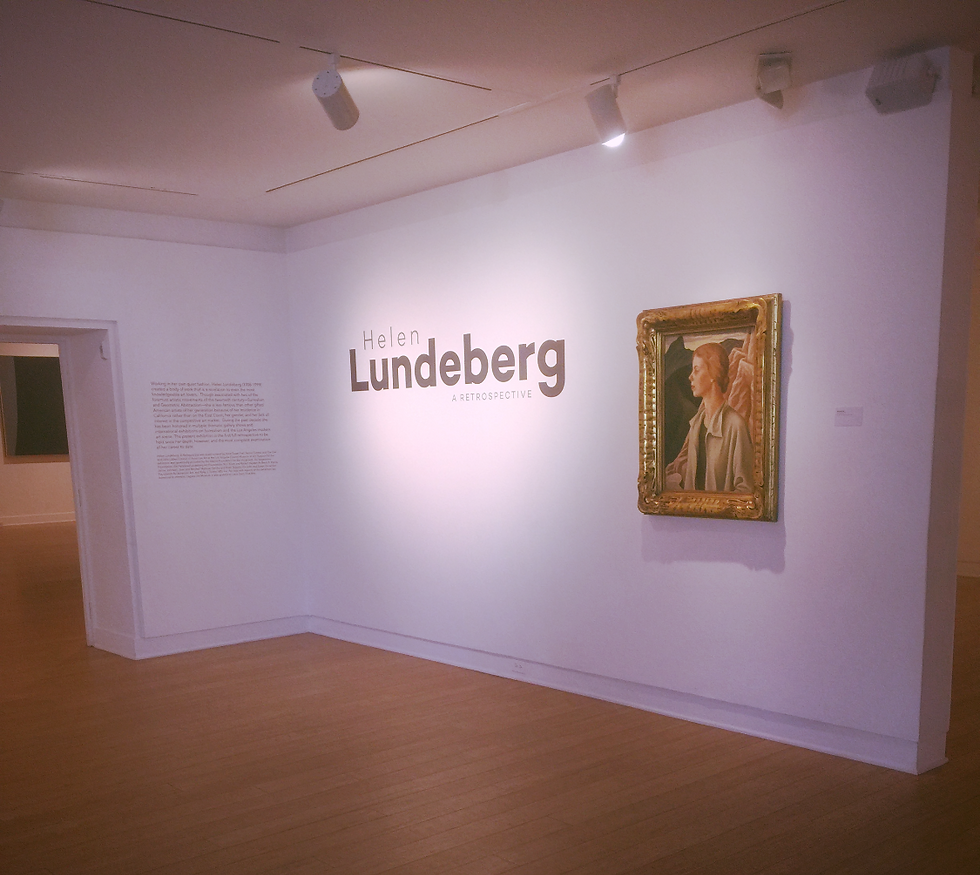Helen Lundeberg: A Retrospective
- Angela Shin
- Mar 15, 2016
- 3 min read

Helen Lundeberg, Self-Portrait, 1944, Collection Zimmerli Art Museum at Rutgers University, Gift of The Lorser Feitelson and Helen Lundeberg Feitelson Arts Foundation. Photo courtesy by Laguna Art Museum.org

Original photo by Angela Shin
On February 21, 2016, Laguna Art Museum proudly presented Helen Lundeberg: A Retrospective, an exhibition that displays a comprehensive work of Helen Lundeberg. Helen was the co-founder of Post-Surrealism in 1934 and became a key figure in 20th century California art. Laguna Art Museum curates premier collections of California based art. Helen Lundeberg is one of their finest artists to exhibit.
Just as you push through the big glass doors on the first floor of the museum, you’re greeted with Lundeberg’s iconic painting Self Portrait. A blonde haired maiden is looking to the side, hands placed together on her lap, as the colors of the oil paint vibrantly bring her stern expression alive.
As you continue to pass by, you walk into the first area, more like a room, and more of her lyrical oil paintings such as Plant and Animal Analogies, that paints a female torso, a womb, a fetal brain, and blood vessels. Her refined brushstrokes bring the anatomy to life forcing you to focus on the content rather than the brushstrokes itself. Helen Lundeberg, a pioneer as a woman artist, created many works that were self-referential alluding to herself. Unlike European Surrealism that relied on dreamy imageries without any real order, Post-Surrealism found its basis on a sense of control and direction. Such artists, like Helen, explored psychology and systematically used personal expression in their art. Works like Self Portrait and Plant and Animal Analogies were produced in 1930s-1940s where poetic and lyrical content were the dominant theme.
Entering the next room, her style of painting takes a dramatic turn. You see paintings like Silent Interior and By the Sea, that depict blocks of different geometrical shapes contrasting each other by different hues of blue, grey, and beige. Helen shifted her focus to non-objective abstract forms with a primary focus on depicting space during the 1950s. If her works in the other room were vibrant and colorful in a oil medium, paintings in this room were soft and minimalistic painted with petrachrome to avoid distractions.
The next room took another turn in terms of color. The paintings were brighter and fresher with usage of acrylic paint. Various paintings were titled, Untitled, and consisted colors of a softer hue than her earlier oil works but similarily vibrant in a pastel toned way. Figures were more fluid compared to the rigid and solid shapes and were created without real observation but more of an illusionistic array of shapes on a canvas. Helen wanted to paint architecutal space in a flat form.
All in all, the small and cozy gallery consisted up to 50 works of her art, categorizing it by her Post-Surrealistic years, her "geometrical space" years, and her "2-dimensional architectural shape" years. The artworks were neatly displayed on par hung on stark white walls, calling attention to Helen’s dynamic, retrospective color, range, and medium. The exhibition was divided into four abstract cornered rooms that grouped the works in chronological order starting with pieces from her earlier years and ending with ones from her last. The atmosphere was very quiet and serene as the art really spoke for itself. The gallery was incredibly clean and air conditioned well allowing you to escape from the early Summer heat wave outside into the world of abstract realism.
The audience was a diverse mix of youth and old. In the first room there was a family of four whom were looking at Tree in the Marsh, an abstract oil painting, in awe of how many shadows of grey can create an illusion of a naked tree. There was a young couple, hand in hand, in the next room as they quietly contemplated on what the geometrical shapes of The Elements resembled.
After reaching the end of the exhibition, there was a group of older ladies in their 60s, dressed to impress in their pearls and hats, in the lobby as they discussed amongst each other on which was their favorite.
“She’s such a genius! So talented.” gushed Norma, the loudest one in the group.
Their finalists were the Selma, a painting of a portrait of Lundeberg’s mother hanging on the wall with a sunflower beneath it and Self Portrait of Inez both from Helen’s earliest years.
“We’re older, our eyes are bad so we like more color.” Norma's friend Gina added.
Janice, the museum’s creative associate sums it all in her words.
“Lundeberg’s exhibition is so well composed and curated that people of all ages enjoy it. I don’t think I had one person who said they didn’t like it.”
The exhibtion is held until May 30, 2016.




Comments